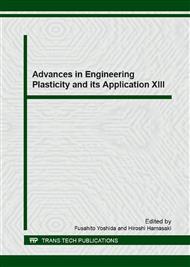p.483
p.489
p.495
p.502
p.511
p.517
p.523
p.529
p.537
A New Algorithm of the Boundary Restraining Force for One-Step Inverse Analysis
Abstract:
In one-step inverse analysis, the restraining force produced by blank holder and draw bead need to be replaced equivalently by the nodal force to obtain a rational blank shape. But the distribution of the equivalent restraining force should not be uniform. A self-adaptive algorithm of the equivalent restraining force is presented in this paper. By comparing the initial configration contour line of the part obtained from three different methods (self-adaptive algorithm, uniformly distributed algorithm and a commercial software Fastform) with experimental results, the self-adaptive algorithm is proved to be accurate and convenient.
Info:
Periodical:
Pages:
511-516
Citation:
Online since:
December 2016
Authors:
Price:
Сopyright:
© 2017 Trans Tech Publications Ltd. All Rights Reserved
Share:
Citation:


